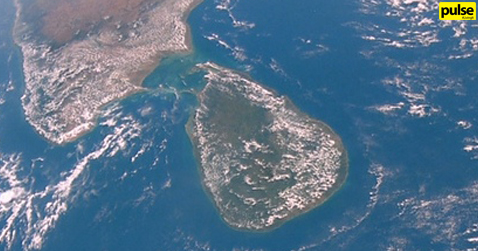2020 May 22
Climate change is a growing problem for all of us and our island is no exception. Our shores are shrinking, dying and being damaged as we speak and the consequences are much more dire than we think.
Storm Surges and Runoff

When there are intense storms like typhoons and cyclones in coastal areas, water is pushed higher up on the beach when strong winds are formed. This event is called storm surging and it can wreak havoc across coastal towns and cities. Floods become more common and begin to threaten lives. Heavier rainfalls only add to the hazard.

A phenomenon commonly referred to as ‘Runoff’ takes place when storms are so big that it rains more water than the ground can absorb. This is when rainwater stays above the ground and floods low-rise areas. We’re already starting to see the consequences of climate change. On the 15th of May, a 48-year-old man and 56-year-old woman died due to a runoff in Kegalle: The man was swept away by floodwaters while the woman remains missing after her house collapsed in on itself and has been confirmed to be dead. Kegalle has just received its highest rainfall ever last weekend and things look like they’re going to get worse.
Rising Sea Level

As greenhouse gasses trap heat inside the atmosphere, glaciers start to melt and increase the volume of oceans all over the globe. The sea has risen over 200 millimetres over the last 1 1/2 decades and almost 40% of that has been over the last 25 years. Scientists have warned world leaders to brace for impact as a sharp rise in those statistics have been predicted to occur in the next 80 years. Specifically, anywhere between 300 millimetres (0.3 metres or 1 foot)and 1200 millimetres (1.2 metres and 4 feet). The worst-case scenario is an increase of 1800 millimetres or 6 feet but, even though it’s completely possible, it’s astoundingly unlikely.
But what does this mean for Sri Lanka?

Although 8 more metres in the global sea level is required to fully sink our entire island, some areas will succumb quicker than others. Reports have shown that by 2025 (in the next 5 years), Negombo will mostly be seawater. These are the downsides when residing on the west coast – it’s mostly lagoons. This makes its height of 2 metres above sea level pointless against global warming. Areas along the southern coast like Galle are very likely to lose their beaches to the Indian Ocean. Lakes and lagoons will completely flood over. As for Colombo, the government will need to invest in the expensive equipment needed to protect Marine Drive and the railroad along with it as the coasts are expected to flood over soon. Port City will be directly affected if drastic preservation methods aren’t put in place and the Beria Lake will receive an influx of unwanted seawater.
Marine Extinction
The egg and larva of most fish and marine life are only adapted to small ranges of temperature, so when fish reproduce, their offsprings die, sometimes unborn as higher temperatures act as a catalyst for the already somewhat-acidic seawater. The yolk inside them which they use as food to survive on, decay and their cartilage takes on damage until the offspring itself dies. The rising temperature of the earth also increases the temperature of the sea and thus kills off marine life.
Over 41 our of 90 freshwater fish alone in Sri Lanka are facing extinction. The animals themselves (not just freshwater fish) have begun noticing the rise in temperatures and are migrating to the North. More species are expected to die off in the next 25 – 50 years around the island. This puts our island in a very dire situation as the fisheries sector plays a crucial role in Sri Lanka’s social and economic life. Our economy would absolutely crumble if sea animals become scarce.
Coral Reef Extinction
Coral reefs are huge tourist attractions in Sri Lanka, drawing in thousands of tourists each year. However, this comes with a number of drawbacks as air pollution around waterfront areas increase. This is essentially because the ocean takes in carbon dioxide into its chemical makeup to rid the air of some greenhouse gases, resulting in fluctuations in its own makeup. Its pH level starts reducing and the ocean itself becomes acidic which causes corals to reproduce less. More carbon dioxide in the air also varies levels of rainfall (discussed further below) which bring sediment and pollutants into the water as it seeps back in. With water then clouded and murky, reefs are starved of sunlight and do not grow properly.

Climate change doesn’t alter only precipitation, but storm patterns as a whole. They influence a higher frequency of strong storms that physically damage reefs. The common side effect of rising sea levels causes sedimentation, the deposition of eroded particles into the sea bed, on coral reefs which smother the corals in dirt and soil. Confined gases also increase the ocean’s temperature, primarily around tropical countries like Sri Lanka and cause thermal stress which is tension set on objects as they heat up, fracturing them. Coral bleaching is a consequence of this. They “bleach” when the stress makes them release algae that live inside their tissues and starve them, eventually killing them off.
This list of damages isn’t even complete. Coral reefs are dying at an alarming rate. Over 51% of the world’s reefs have died over the past year and scientists have predicted the death of the rest of the 90% to occur in the next century. That isn’t a very long time.
As we stand around waiting for something to be done about climate change, our country is being submerged and washed away. We as citizens of Sri Lanka need to take action and fast. As mentioned before, we might not have as much as 5 years before consequences become deadly and the ocean starts reclaiming our land.










